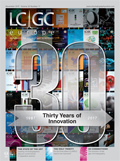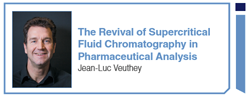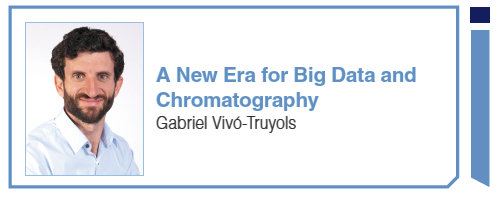Hitting Thirty
LCGC Europe is celebrating a glorious past and looking ahead to a buoyant future.
LCGC Europe is celebrating a glorious past and looking ahead to a buoyant future.
LCGC Europe is thirty years young this month. A thirtieth birthday is widely regarded as a milestone. Some people look to the future at thirty with trepidation, while others embrace this new stage in their lives, and the challenges ahead, with zeal. LCGC Europe certainly falls into the latter camp. Since the magazine was launched in 1987, we have always embraced the future, and the speedy pace of publishing, with relish.
A LOT has changed in both publishing and chromatography since LCGC Europe’s humble beginnings, but readers can continue to expect the flagship print issues to provide unbiased peer-reviewed technical articles, trusted troubleshooting advice, insights from our world-renowned columnists, and best-practice application solutions. The ultimate aim is to keep readers informed of the latest trends in separation science, innovative analytical approaches, and practical information that can help them perform their jobs more effectively and efficiently. The print magazine currently has an audited circulation of more than 26,000 chromatographers in Europe.
We are also keeping our print magazine fresh: A new celebrity columnist joined our stellar cast in 2017: Koen Sandra, from the Research Institute for Chromatography (RIC), Belgium, who now offers illuminating insights into current practices in biopharmaceutical analysis in his Biopharmaceutical Perspectives column. Dwight Stoll from Gustavus Adolphus College in Saint Peter, Minnesota, USA, recently took over the “LC Troubleshooting” column from the legendary John Dolan and will continue to help you solve your practical LC problems. Another new face will be joining our coterie of celebrated columnists in 2018: Deirdre Cabooter from KU Leuven in Belgium will keep readers abreast of key developments in pharmaceutical analysis in a new column called Pharmaceutical Perspectives. Our new Analysis Focus section will interview separation scientists from cutting-edge research laboratories who are providing solutions to problems in core application areas.
We have also set the bar high for readers and advertisers with our portfolio of innovative digital products. The team are particularly proud of LCGC’s global digital publication, The Column, which is now published monthly and provides readers with company and research news, events, opinion pieces, in-depth interviews with leading separation scientists, reviews of important conferences, troubleshooting tips, and short, practical feature articles describing how new chromatography technologies benefit the working chromatographer in practice. Subscription is quick and easy at: goo.gl/9r6Fy3
This year, we also began publishing special issues of The Column focusing on specific sectors, including food-, environmental-, pharmaceutical-, and biopharmaceutical analysis, as well as newsletters from The Column associated with these sectors.
We also led the way in capturing the leading lights of separation science on camera with LCGC TV. Check out all the interviews and the rich tapestry of valuable archive content on our website: www.chromatographyonline.com, which will be getting a major revamp in 2018. You can also download a range of free innovative e-books with practical information and other useful resources on core topics from the site too. These are proving to be a hit with readers.
CHROMacademy, produced by LCGC and Crawford Scientific, is one the world’s largest e-learning platform for analytical chemists with a mission to elevate practical and theoretical expertise in chromatography amongst younger scientists embarking on their careers and older scientists who could do with brushing up their skills (and perhaps should know better). Find out more at www.chromacademy.com
LCGC was also a pioneer in promoting and producing educational and sponsored webinars presented by the crème de la crème of the chromatography community and 2018 will be no different. Find out what is on the horizon from our website.
Our passion for innovation has also led to the launch of the LCGC Europe/HTC Innovation Award next year to celebrate the work of a scientist who is innovatively evolving the field of hyphenated techniques. The award is open to any scientist under 45 and will be presented at HTC-15, which is in Cardiff from 24–26 January 2018. The winner will be selected by the HTC scientific committee and will receive a 1000 Euro travel grant and free conference registration to attend HTCâ15. Nominations will also be accepted from LCGC Europe readers for the judges to consider. Please send your nominations and reasons for your selection by 24 November 2017 to Alasdair.Matheson@ubm.com.
The sales and editorial team on LCGC Europe and LCGC North America aspire to stay in tune with novel trends in chromatography and publishing, and we believe we have raised the bar for editorial quality as well as marketing opportunities for vendors. We would like to thank all the companies who have supported our print and digital portfolio, our readers, and the esteemed LCGC editorial advisory board (EAB), for their continued advice and support.
There is a lot going in chromatography in 2017-and beyond-and LCGC Europe aims to be the first port of call and a “one-stop shop” information resource for practising chromatographers. As LCGC Europe hits thirty we are proud of our past, but have our eyes firmly fixed on the future.


Editor-in-ChiefAlasdair.Matheson@ubm.com


.png&w=3840&q=75)

.png&w=3840&q=75)



.png&w=3840&q=75)



.png&w=3840&q=75)

















